Editor's note: This is one in a series of articles looking back on the department's
first 25 years-remembering the people, issues and cultural forces that have
shaped the agency and the milestones Mn/DOT has achieved.
 |
|
Al Wothe, then resident
engineer at Detroit Lakes, supervises a reconstruction project on Hwy
59 near Fergus Falls. Staff photo
|
Highways still carry the eye to the horizon—as well as carry people, products
and myriad services to just about anywhere imaginable. Nearly everything else
about the state’s highway system, though, has changed since Mn/DOT’s formation
25 years ago. Changes emerged in the way roads and bridges are planned, built
and maintained.
The Intermodal Surface Transportation Efficiency Act of 1991 and TEA 21 in
1998 brought changes in the way roads are prioritized, financed and planned.
Environmental requirements made a significant impact. Technology continues to
transform all phases of highway construction, bridge design, maintenance practices,
materials selection and countless other highway applications.
"When Mn/DOT was created in 1976, we were still building the interstate
highway system; now we’re rebuilding the system we built 25 to 30 years ago,"
said Mike Marttila, state construction engineer.
Martilla notes, however, that now things in highway construction are very different.
"We have more automation and fewer people," he said. "And contractors
now have more responsibility, such as doing staking and assuring that asphalt,
concrete and other materials meet quality and other design standards."
Added Don Orgeman, contract administration engineer: "We used to use transits
and chains to do surveying. Now some surveying is based on the global positioning
system."
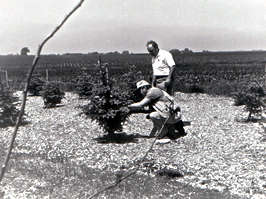 |
|
Paul Walvatne (kneeling),
Environmental Services, and Charles Marsden, transportation generalist
at Austin, inspect trees and shrubs planted along I-90 near Dexter designed
to stop and hold blowing snow to prevent drifts from reaching the freeway.
Photo by Craig Wilkins
|
Marttila and Orgeman said Mn/DOT supported other changes as well.
"We now offer incentives for contractors to finish their work ahead of
schedule, not just penalties for being late," Orgeman said. "And we
mandate better performance such as roads that are smoother and more durable
and pay incentives for high-quality construction."
Both credit their colleagues in research who have developed higher quality
materials such as the long-lasting asphalt pavement, SuperPave, and durable
concrete pavements.
Construction officials say other changes also mark the construction landscape.
The increase in traffic makes getting work done more difficult and more dangerous.
Some activity, especially in the Twin Cities metro area, is done in stages or
at night and weekends to minimize traffic conflicts.
Amidst the changing landscape and new challenges, however, Mn/DOT completed
scores of major highway projects during the past 25 years that strengthen the
state’s principal transportation mode. Projects include completion of the interstate
system, the rebuilding of the I-35E/I-94 commons area in St. Paul and the extension
of I-35 through Duluth.
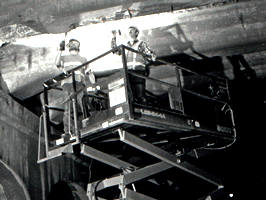 |
|
The Metro Division's
Matt Ironi and Gary DeMorett perform bridge maintenance at night on a
Twin Cities metro area bridge. Mn/DOT started night maintenance work in
the Twin Cities in 1986 to reduce workers' exposure to heavy daytime traffic
and to lessen the effect of maintenance work on drivers during the day.
Photo by Kent Barnard
|
Bridge design undergoes transition
The business of designing and building bridges experienced major changes since
1976 as well.
Arlen Ottman, Bridges and Structures, said during Mn/DOT’s first years bridges
were designed by hand with pens on stretched linen. Computers quickly changed
that, however. Greater public concern with design and esthetics also changed
the bridge building process. And bridge failures in other states during the
1960s and 1970s alerted Mn/DOT bridge designers about danger areas such as scour,
(water washing away support piers) and girder failures—and the need to create
designs to avoid them.
Public concern about esthetics led to design changes for the Lake Street Bridge
that connects Minneapolis and St. Paul, the rebuilt Mendota Bridge and the Mantorville
Bridge at Mantorville in Dodge County that complements other historic structures
in the city. An increased awareness of other modes led designers to include
bike and pedestrian lanes on bridges and to use bridges as a way to connect
existing bike trails.
Mn/DOT engineers also found ways to extend the lives of bridge decks by using
epoxy-coated rebar to resist rusting and using dense "low-slump" concrete
overlays to stand up to heavier truck traffic.
 |
|
Curt Turgeon and Roger
Olson, then both with Materials and Road Research, check installation
of asphalt mixed with recycled tires that was used to pave a bikeway in
the Twin Cities metro area. Photo by Craig Wilkins
|
Research led to development of environmentally sound practices, such as no
longer using paint containing lead and removing existing lead paint from bridges.
Another research product—pre-stressed concrete beams more than 150 feet long—gives
increased flexibility at lower cost than steel beams. Pre-stressed concrete
beams 155 feet long were used for the new Hwy 101 bridge at Elk River, for example.
Ottman and Ray Cekalla, Bridges and Structures, said the past 25 years also
saw a peak in bridge building that created a legacy of transportation landmarks
for future generations. Bridges they cite include the new bridge at Wabasha,
the Richard Bong Bridge connecting Duluth and Superior, Wis., the gracefully
arched Lake Street Bridge connecting Minneapolis and St. Paul, the I-94 bridge
over the St. Croix River, the Hwy 15 Bridge of Hope in St. Cloud and the Hwy
371 Bridge in Baxter.
Each structure, said Dan Dorgan, state bridge engineer, reflects good engineering,
appreciation of the natural environment and a commitment to safety.
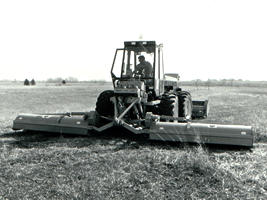 |
|
A mower designed jointly
by employees from the Morris Maintenance Area and the Tiger Corporation
of Benson gets a field trial from Mitch Fett, transportation generalist,
near the maintenance area headquarters. Photo by Craig Wilkins
|
Maintenance practices go high-tech
During the past 25 years, highway maintenance practices changed as well. By
using information from sources such as Road/Weather Information System, maintenance
forces can better anticipate snowstorms and other weather events. New "anti-icing"
techniques allow crews to apply chemicals before a storm hits, reducing the
amount of salt and time needed to clear roadways.
Snowplow trucks have become sophisticated places to work. Cabs are now full
of sensors, monitors and controls that give drivers more knowledge about weather
and road condition to help them make better decisions, noted Mark Wikelius,
state maintenance engineer.
Market research, another recent innovation, gives maintenance managers a clear
picture of the level of services Minnesotans expect and how to allocate resources
to meet them.
"Historically we’ve done a really good job," said Mark Wikelius,
state maintenance engineer, "and people expect a high level of service
from us in areas such a snow removal. Knowing what they expect and what we can
reasonably deliver is a major change and a major advantage."
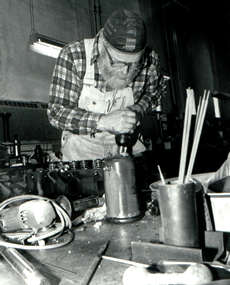 |
|
Roger Wobschall, then
a heavy equipment mechanic at Owatonna, performs repair work on a truck
engine. Photo by Peter Winters
|
Information sharing grows exponentially
The past 25 years has also seen an explosion in information sharing on maintenance
practices with other states and countries such as Norway, Finland, Sweden, Canada
and Japan.
"We now have a much bigger peer group," Wikelius said.
Information sharing also marks highway-related research. Initiatives such as
the Minnesota Road Research Project facility on I-94 near Monticello give researchers
road performance data they can share worldwide.
Gerry Rohrbach, director, Materials and Road Research, said Mn/DOT’s past 25
years of innovation strengthened the "three-legged stool" needed to
create high-quality, long-lasting projects—"design it properly, use good
materials and build it right."
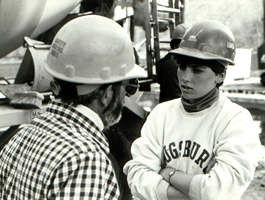 |
|
Patti Tix, then a construction
inspector at Metro, meets with a contractor’s employee during the building
of the new Lake Street/Marshall Avenue Bridge that connects Minneapolis
and St. Paul. Photo by Craig Wilkins
|
Jim Swanson, Program Delivery assistant commissioner and assistant chief engineer,
said the efforts of "good, hard-working Mn/DOT people" made the department’s
accomplishments in road and bridge work a success.
Swanson’s career started in 1968 when he was a highway technician building
I-94 in St. Paul. He later became an engineer and managed projects such as the
new St. Paul High Bridge. He was named Mankato district engineer and then assistance
commissioner for Program Delivery.
"We thought we had seen the end of big projects with the end of the interstate
system, but we just approved a $200 million design-build project in Rochester.
"Our projects are getting bigger and more complicated and faster moving.
Fortunately, we have people here who are experienced and willing to work hard
and new people coming in who are bright, smart and very knowledgeable. That
bodes well for the future of Mn/DOT."
By Craig Wilkins
|



